By Brad Walker, Rivers Director February 1, 2016
In late December 2015 the St. Louis Post-Dispatch published an op-ed by the Missouri Coalition for the Environment (MCE) and Sierra Club regarding the America’s Watershed Initiative’s (AWI) Mississippi River Basin Report Card and a response from the CEO/President of the Waterways Council Inc. (WCI) compels this reply. Our op-ed responded to several Post-Dispatch articles about the Report Card’s release with two specific criticisms: the Report Card shows a bias towards barge navigation with the AWI’s organizational structure and there was a double-standard used in grading the ecosystem versus transportation. On January 11, 2016, the Post-Dispatch printed a response to our op-ed from the CEO/President of the Waterways Council Inc. (WCI), addressing only our first criticism and perpetuating myths about the public benefits of barges on the Upper Mississippi and Illinois Rivers.
Before we discuss the details of the WCI response we have two important points to make.
A problem we have today is that because all of our major rivers have been so severely altered for navigation – navigation dams built on low water segments to create slack water pools and channelization on open segments to create canals for easier maintenance – most people have no real concept of what a healthy functioning river looks like. This is why we referred to the IWS in our editorial as “nostalgically-called rivers,” not because as WCI suggested we do not value rivers as a national treasure, but because the difference between an industrialized navigation channel is so drastically different from an ecologically functioning river, and because unfortunately most people simply do not know what we have lost.
If WCI truly wants to improve the health of the river, they would support the decoupling of the ecosystem restoration work from NESP and then lobby for its full funding so those scientists, engineers and contractors can start building restoration projects. Expanding the current barge system, however, cannot improve the river’s health since the Inland Waterways System (IWS) is the reason it is degraded in the first place.
Bias within the Report Card Process
While WCI’s response implies that simply because “commercial waterways interests were actually a very small part of the overall team” who made recommendations that there is no bias towards the navigation system; a deeper dive into the connections of people within both the Steering Committee and the Transportation Review Team reveals a much larger segment of those making decisions are tied directly or indirectly to river navigation interests.
Our review of the 14 member Steering Committee indicates that eight of them are in varying degrees tied to, would benefit from, and/or promote barges or lock expansion on our rivers. At the same time, there is not a single environmental organization or taxpayer advocate organization on the Steering Committee to counter corporate bias.
The Transportation Review Team, which was responsible “to advise on refining the set of indicators used and how they are scored” is overwhelmingly (all but one of the 12 members) drawn from people working in the barge industry or people focused primarily upon river transportation. Neither the rail nor trucking industry was represented on this so-called Transportation Review Team.
Inland Waterway System Subsidies
WCI’s alleged “puzzlement” as to why we claim the (IWS) is highly subsidized is disingenuous and misleading. Since they claim to be puzzled, we will explain what they should know.
First, the major subsidies that the IWS has received include the cost of the initial construction of the IWS, the costs of its ongoing operation and maintenance (approaching 80 years’ worth), and until 1986 the cost of all “modernization” (major rehabilitation of existing infrastructure and construction of new infrastructure) of the system that have been completely paid for by the taxpayer. It is important to note that back in the late 1920’s the Corps’ local leadership originally advised that the system should not be built (page 22), because they did not think it economically viable – meaning it would be a taxpayer burden. Beginning in 1986 the cost of all modernization was to be shared equally between the barge industry and the taxpayer, a tiny barge industry concession resulting from the construction of the Melvin Price Locks & Dam. The taxpayers (the users and beneficiaries that WCI says are shirking their responsibilities) continue to pay all of the operation and maintenance costs for the IWS. On a percentage basis, the taxpayers pay at least 90% of the IWS costs – which from all perspectives should be considered highly subsidized. The taxpayer burden has increased beyond 90% when Congress has reacted to barge industry complaints and waived or reduced industry’s 50% cost share, as was done in the 2014 Water Resources and Reform Development Act that shifted $500 million of the projected remaining cost of the Olmsted Locks & Dam onto the taxpayer.
Second, the 50% modernization cost share that the barge industry provides through a fuel tax had not been increased for about 20 years before 2014. The 9-cents per gallon increase that industry agreed to in 2014 does not come close to covering inflation or increased demand from the new projects industry wants built. The increase should have been closer to 30-cents to provide adequate funding just for the barge industry’s modernization obligations. This small increase still does not include any funding for the operation and maintenance and necessary ecosystem restoration costs that taxpayers still totally fund. Frankly, we believe that the barge industry agreed to this small tax increase primarily to avoid, or at least delay, the possible imposition of lockage fees that many past Administrations (see page 9) have proposed to fill the IWS funding gap. Lockage fees are a more direct and fair payment method in the segments of the IWS with locks, but industry has strenuously fought lockage fees.
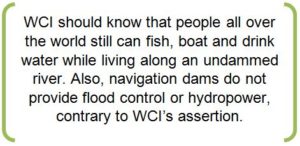 Finally, the implication that locks & dams provide unique or otherwise unattainable benefits for fisherman, boaters and water supply is specious. WCI should know that people all over the world still can fish, boat and drink water while living along an undammed river. In fact, people south of St. Louis and living along the lower Missouri River are examples of such people. Also, navigation dams do not provide flood control or hydropower, contrary to WCI’s assertion.
Finally, the implication that locks & dams provide unique or otherwise unattainable benefits for fisherman, boaters and water supply is specious. WCI should know that people all over the world still can fish, boat and drink water while living along an undammed river. In fact, people south of St. Louis and living along the lower Missouri River are examples of such people. Also, navigation dams do not provide flood control or hydropower, contrary to WCI’s assertion.
For more information on subsidies, take a look at what the rail industry contributes to their own system on an annual basis and compare it to the minuscule amount the barge industry contributes to the system they depend upon in the chart below.
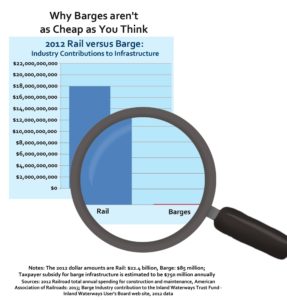
Congestion, Energy Efficiency and Air Quality
WCI uses blatant hyperbole when they say traffic congestion would be “catastrophic” without barges (there are other examples of hyperbola as well in their response). Of course, we did not suggest anywhere within our op-ed that barges should be removed from our rivers as they imply, so we will let Forbes magazine, not exactly a bastion of environmental thought, address how a shift of commodities shipped on barges to rail and truck might impact us. Here’s an excerpt:
In terms of barge lanes as a national interest, times have changed. Rivers remain important for moving cargo, but the nation could now get by without them. According to the U.S. Department of Energy, America’s waterways are used for shipping some 160 billion ton-miles per year (1 ton-mile is the movement of 1 ton of cargo over a distance of 1 mile), most of that on the Mississippi system. Compare that with railroads, which do 1.3 trillion ton-miles, and trucks, also at 1.3 trillion ton-miles–all at very little cost to taxpayers. Splitting all that waterborne cargo between them would require roughly 10% more trains and trucks. It could be done, and arguably should be, in a post-sequestration era.
The Forbes article also has an informative subsidy versus freight movement graphic we include in the infographic below.
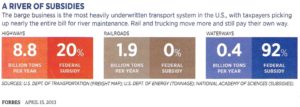 WCI’s assertion that there are energy efficiency and air quality benefits has some merit when talking strictly about trucks, which by the way barges heavily depend upon. But studies clearly show, especially in the river segments north of St. Louis (Upper Mississippi and Illinois Rivers) that rail is more efficient and cleaner than barges (see Regional Fuel Efficiency chart below). These same river segments are also the most heavily subsidized (page 39) by the taxpayers.
WCI’s assertion that there are energy efficiency and air quality benefits has some merit when talking strictly about trucks, which by the way barges heavily depend upon. But studies clearly show, especially in the river segments north of St. Louis (Upper Mississippi and Illinois Rivers) that rail is more efficient and cleaner than barges (see Regional Fuel Efficiency chart below). These same river segments are also the most heavily subsidized (page 39) by the taxpayers.
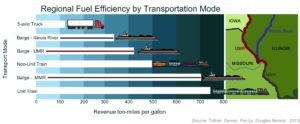
The Navigation and Ecosystem Sustainability Program
To put the WCI response to our op-ed into perspective we need to go back to February 2010 when the Nicollet Island Coalition released a major report titled Big Price – Little Benefit at a small press conference in St. Louis that strongly attacked what was likely the most important navigation project on the Upper Mississippi River to WCI (and for full disclosure I authored that report). WCI did not write a response to the report then and never has to our knowledge. So why attack this particular 700-word op-ed about a report card? We have our suspicions but first we will address the specifics of the WCI response.
The river segments mentioned above are also the primary site of the IWS portion of the Navigation and Ecosystem Sustainability Program or NESP, which WCI seemed to mention with zeal as if we were withholding essential information. Perhaps they forgot that we had previously analyzed NESP in the Big Price – Little Benefit report. So let’s discuss NESP, a topic we actually have plenty to talk about.
WCI seems to believe that the combining of two distinctly different activities – navigation projects (that are primarily responsible for the ecological damage to the river) with ecosystem restoration projects (that are pursued to address the ecological damage of navigation projects) would somehow solve all of our river-related problems. If both programs are pursued, different groups within the Corps will be responsible for constructing and managing each and they are more than capable of coordinating their work. The irony is in the combining of these two conflicting programs, since there is no functional reason to combine them. To add insult to injury, the barge industry has no obligation to contribute any funding for the ecosystem restoration projects; that’s all on the back of the taxpayers, who are however obligated to pay 50% of the new navigation projects within NESP.
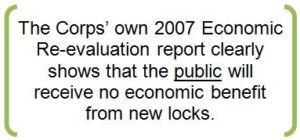 NESP as a coupled program is actually a Trojan Horse in that it looks pretty good on the outside but one must look deeper than its skin to see that it really is intended to benefit industry and the industrial agriculture system. It provides the appearance of cooperation but in reality is being used to manipulate support for the construction of large-scale navigation projects (new locks) that are not economically justified. You don’t have to take our word for that: the Corps’ own 2007 Economic Re-evaluation report (and there is much history involved with getting to the point of the Corps having to write a re-evaluation of NESP) clearly shows that the public will receive no economic benefit from new locks. In fact, the Corps report indicates the public will lose money on their investment. Below is the Corps graphic Range of Possible Traffic Forecasts from the final version of their re-evaluation report that show the Benefit-Cost (BC) ratios for the scenarios used to analyze NESP economic viability.
NESP as a coupled program is actually a Trojan Horse in that it looks pretty good on the outside but one must look deeper than its skin to see that it really is intended to benefit industry and the industrial agriculture system. It provides the appearance of cooperation but in reality is being used to manipulate support for the construction of large-scale navigation projects (new locks) that are not economically justified. You don’t have to take our word for that: the Corps’ own 2007 Economic Re-evaluation report (and there is much history involved with getting to the point of the Corps having to write a re-evaluation of NESP) clearly shows that the public will receive no economic benefit from new locks. In fact, the Corps report indicates the public will lose money on their investment. Below is the Corps graphic Range of Possible Traffic Forecasts from the final version of their re-evaluation report that show the Benefit-Cost (BC) ratios for the scenarios used to analyze NESP economic viability.

A BC below 1.0 means the benefit is less than its cost or a loss to those who are paying. Traffic volumes have been somewhere between the Low Traffic Scenario and Flat and Falling Traffic (represented by the 0.2 BC and 0.4 BC below) for the last couple of decades, never coming close to the forecasts used to justify the Melvin Price Locks & Dam at Alton, Illinois. If the locks proposed in NESP are built, the taxpayers will lose somewhere between 60 cents (1.0 BC – 0.4 BC = 60 cents) and 80 cents for every dollar invested. The High Traffic Scenario (HTS) in the graphic represents a very optimistic forecast of barge traffic similar to those used to justify Melvin Price Locks & Dam.
The high level of probable financial loss should be enough for the taxpayers to scream “NO!” to building these proposed locks, but there are other concerns, including the additional environmental damage that will result from their construction. We are also concerned that the funding for the ecosystem restoration projects will never materialize in any meaningful amount. Congress has very rarely fully funded the current small-scale restoration program on the Upper Mississippi and Illinois Rivers. They have also recently cut in half the funding for the Missouri River Recovery Program, which exists to fix the environmental devastation caused by the construction of the Missouri River Bank Stabilization and Navigation Project. Congress has never shown a real commitment to fixing the messes they have created in our rivers. Proponents of NESP will say “but we have the Comparable Progress clause in the NESP authorization to protect us.” We have included the clause from public law below for your review.
SEC. 8005. COMPARABLE PROGRESS.
(a) IN GENERAL.—As the Secretary conducts pre-engineering, design, and construction for projects authorized under this title, the Secretary shall—
(1) select appropriate milestones;
(2) determine, at the time of such selection, whether the projects are being carried out at comparable rates; and
(3) make an annual report to Congress, beginning in fiscal year 2009, regarding whether the projects are being carried out at a comparable rate.
(b) NO COMPARABLE RATE.—If the Secretary or Congress determines under subsection (a)(2) that projects authorized under this title are not moving toward completion at a comparable rate, annual funding requests for the projects shall be adjusted to ensure that the projects move toward completion at a comparable rate in the future.
The major problem with this clause, if you read it closely, is that nowhere does it use the words “navigation” or “ecosystem restoration” within the context of comparable progress. It simply discusses the requirement for the adjustment of “projects…. not moving forward…..at a comparable rate.” It may be my cynicism showing but projects within the NESP authorization are locks as well as other types of construction activities – both navigation and restoration related. It does not say that the navigation and ecosystem restoration components must move forward at comparable rates. The Corps Implementation Guidelines have added those clarifiers but are they defensible? Given the completely avoidable vagueness of this clause, combined with Congress’s apparent disdain for fully funding ecosystem restoration projects and their often over-the-top efforts to satisfy the barge industry, this clause does not provide me any comfort that the NESP restoration projects will be built. If anything, this language has worked against ecosystem restoration of these rivers.
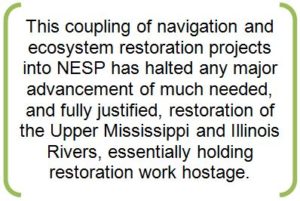 Because of the low Benefit-Cost ratios for the navigation portion of NESP, neither the Bush nor Obama Administrations have ever included any construction funding for NESP within their budgets. The result then of the coupling of navigation and ecosystem restoration projects into NESP is the halting of any major advancement of much needed, and fully justified, restoration of the Upper Mississippi and Illinois Rivers, essentially holding restoration work hostage for eight years.
Because of the low Benefit-Cost ratios for the navigation portion of NESP, neither the Bush nor Obama Administrations have ever included any construction funding for NESP within their budgets. The result then of the coupling of navigation and ecosystem restoration projects into NESP is the halting of any major advancement of much needed, and fully justified, restoration of the Upper Mississippi and Illinois Rivers, essentially holding restoration work hostage for eight years.
WCI’s emphasis upon NESP rather than the issues we raised about the AWI Report Card puts meat on the bones of our assertion that navigation work within NESP is a prime motivator for the current manifestation of the report card. This we believe is a primary reason for the WCI response to our op-ed. Because construction funding has not ever been budgeted for NESP, navigation interests have lobbied for Public-Private Partnerships (P3) to attempt to bypass the legal obligations of the NESP authorization. One is currently being developed for the Illinois River portion of NESP navigation projects. Only time and public engagement will reveal the level of manipulation that might ensue with P3s.
WCI then mentions three conservation organizations that have worked with navigation interests in lobbying for NESP as a “balanced approach.” There has never been anything remotely close to a balanced approach on our rivers and NESP, as we have pointed out above, will not provide it. We must mention that those three organizations joined forces with the navigation industry before the release of the version of the Economic Re-evaluation report that included the Benefit-Cost ratios. Most of the environmental and conservation community, however, has withheld its support of NESP based upon the lack of economic justification for the proposed locks. Unfortunately, but unsurprisingly, Congress authorized NESP before that version of the report was released as well.
Mississippi River Basin Ecosystems Health
The condition of our major rivers, not just the Upper Mississippi and Illinois Rivers, is unfortunately not deserving of a “C” grade. It is much lower than that. There is more than adequate information available to make a more accurate determination, but per a member of the Ecosystem Review Team, the metrics used to determine the grade were limited to data that was available for all river segments. As a result the baseline for at least two metrics was limited to 2006, even though the Corps began completely altering these rivers many decades ago. In 1999 the US Geological Survey released the Ecological Status and Trends of the Upper Mississippi River System – 1998, an excellent report detailing the poor conditions of both the Upper Mississippi and Illinois Rivers. The Report was intended to be a living evaluation through periodic updates. The next and only update thus far is incomparable to the 1999 version.
We have created a document with graphics from the 1999 report that allows one to see the degraded conditions of three of the river segments analyzed for six ecological criterions. We believe that this document clearly shows that the “C” grade for the Upper Mississippi and Illinois Rivers is improper. These three river segments also align with the segments where work is proposed within NESP. You can review the document here.
Conclusion
We have just endured yet another major flood on our Midwest Rivers. It is becoming increasingly obvious that not only is climate change impacting flooding, but studies are clearly showing that past river and floodplain management actions, including river channelization, levee construction, and potentially training structures are also increasing flood levels.
As far as improving the economy, there are plenty of other federally-funded projects that can be built by construction trades that would provide jobs while also providing actual public benefits (a positive Benefit-Cost ratio), not just benefits for corporations and a small group of subsidized farmers that grow corn and soybeans in river floodplains. If our trade balance is dependent upon shipping more corn and soybeans down our rivers and overseas as WCI implies, we truly have bigger problems than we acknowledge.
The Midwest, where that corn and soybeans would be exported from, has a growing food insecurity problem with multi-millions of families in the five UMR states not knowing from one day to the next where their next meal will come from. None of the five states can actually support its own people from what they grow and are dependent upon states like California and other countries for our food. What we really do not need is more corn and soybeans; but a more balanced agricultural system that will free farmers from the yokes of industrial agribusiness corporations would be very much welcomed. We should be balancing our trade deficit by exporting finished goods, not through the exploitation of our natural resources to export low-value agricultural commodities. We can accomplish this by regaining well paying industrial and manufacturing jobs lost through poor trade agreements like NAFTA and the proposed TPP so that we will be better able to buy our own manufactured goods and export any surplus.
Finally, if WCI wants to get serious about improving things in this country, then they might look beyond narrow corporate interests. They could start by trying to develop a navigation system and an agricultural system that would both work within a free-flowing and healthy river without damaging it. Hint here, NESP is not the solution, especially when the taxpayers’ cost share will be so high and their likely benefits will be so low. Let’s imagine and then create something better that could lead to a real shared vision where everyone shares in the benefits.
Apologies to William Shakespeare
